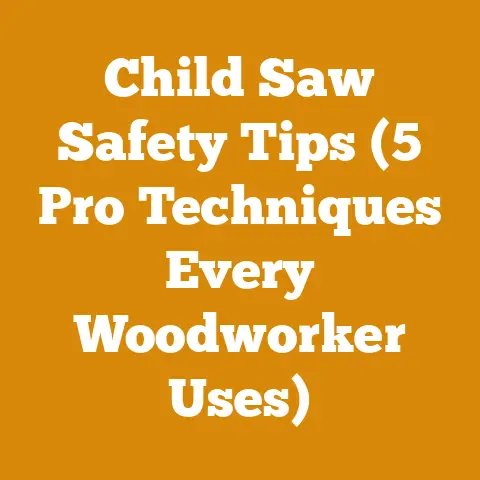Climbing Chainsaw Boots for Spikes (Wide-Foot Arborist Guide)
Let’s dive into the world of climbing chainsaw boots, specifically focusing on options designed to accommodate wider feet and those essential for use with tree climbing spikes.
This guide is crafted for arborists, both seasoned pros and those just starting out, who understand the critical importance of having the right footwear for safety, comfort, and performance.
Climbing Chainsaw Boots for Spikes: A Wide-Foot Arborist Guide
Finding the perfect climbing chainsaw boots can feel like searching for a mythical creature, especially if you have wider feet.
Let me tell you, I’ve been there!
After years of wrestling with boots that pinched, rubbed, and generally made my days in the trees miserable, I finally dedicated myself to finding the ideal solution.
This guide is the result of that quest, combining my personal experiences with research and insights from other arborists.
Why Waterproof Matters: My Muddy Revelation
Before we get into specific boot recommendations, let’s talk about waterproofing.
I remember one particularly soggy autumn day.
I was halfway up a massive oak, battling a stubborn limb, when the rain intensified.
My supposedly “water-resistant” boots quickly surrendered, leaving my feet soaked and freezing.
That day, I learned a valuable lesson: waterproof boots are not just a luxury; they’re a necessity.
Waterproof boots keep your feet dry, preventing blisters, fungal infections, and general discomfort.
They also help regulate your foot temperature, keeping you warmer in cold weather and cooler in hot weather by allowing moisture to escape while preventing water from entering.
Look for boots with a waterproof membrane like Gore-Tex or a similar proprietary technology.
These membranes are breathable, allowing perspiration to escape while keeping water out.
Understanding the Arborist’s Needs
As an arborist, your boots are more than just footwear; they’re a vital piece of safety equipment.
They need to provide:
- Ankle Support: Crucial for stability on uneven terrain and while climbing.
- Steel Toe Protection: To guard against falling objects and chainsaw mishaps.
- Cut Resistance: Essential protection against chainsaw cuts.
- Comfort: Long days in the trees demand comfortable footwear.
- Durability: Arborist boots need to withstand harsh conditions and heavy use.
- Compatibility with Climbing Spikes: The boot’s shank must be rigid enough to support spikes without excessive flex.
The Wide-Foot Challenge
Many boot manufacturers cater to average foot widths, leaving those of us with wider feet feeling like we’re squeezing into shoes that are a size too small.
This can lead to discomfort, blisters, and even foot problems over time.
- Width Measurements: Boot widths are typically indicated by letters:
- B: Narrow
- D: Standard
- 2E (EE): Wide
- 4E (EEEE): Extra Wide
- Finding the Right Fit: It’s crucial to measure your foot width accurately.
You can do this at home with a ruler or visit a shoe store for a professional fitting.
When trying on boots, wear the same type of socks you’ll be wearing while working.
Key Features to Look For
When searching for climbing chainsaw boots for spikes, consider these features:
- Full Grain Leather: Known for its durability, water resistance, and ability to mold to your foot over time.
- Steel or Composite Toe: Provides impact and compression protection.
Steel toes are heavier but offer superior protection.
Composite toes are lighter and don’t conduct electricity or temperature. - Cut-Resistant Material: Look for boots that meet or exceed safety standards for chainsaw protection, such as EN ISO 20345.
- Aggressive Outsole: Provides excellent traction on various surfaces.
Look for lug patterns that grip well in mud, dirt, and on tree bark. - Steel Shank: Essential for providing the rigidity needed to support climbing spikes.
- Waterproof Membrane: Keeps your feet dry and comfortable in wet conditions.
- Padded Collar and Tongue: Enhances comfort and prevents chafing.
- Reinforced Stitching: Adds durability and prevents seams from splitting.
Top Boot Recommendations for Wide-Foot Arborists
Based on my experience and research, here are some top recommendations for climbing chainsaw boots that cater to wider feet:
- EN ISO 20345: A European standard that specifies requirements for safety footwear.
- EN ISO 17249: A European standard specifically for chainsaw protective footwear.
This standard includes different classes of protection based on chainsaw speed.- Class 1: Protection against chainsaw speeds of up to 20 m/s.
- Class 2: Protection against chainsaw speeds of up to 24 m/s.
- Class 3: Protection against chainsaw speeds of up to 28 m/s.
- ASTM F2413: An American standard for protective footwear.
When choosing chainsaw boots, make sure they meet or exceed the relevant safety standards for your work environment.
Breaking in Your New Boots
Breaking in new boots is essential for comfort and preventing blisters.
Here are some tips:
- Wear them around the house: Start by wearing your new boots for short periods around the house to get your feet used to them.
- Use a boot stretcher: A boot stretcher can help widen the toe box and stretch the leather.
- Apply leather conditioner: Leather conditioner can help soften the leather and make it more pliable.
- Wear thick socks: Wear thick socks to cushion your feet and prevent blisters.
- Gradually increase wear time: Gradually increase the amount of time you wear your boots each day.
- Use a boot balm: Apply a boot balm to the areas where you experience rubbing or pressure.
Boot Maintenance: Keeping Your Investment Protected
Proper maintenance is essential for extending the life of your chainsaw boots.
Here are some tips:
- Clean your boots regularly: Use a brush and mild soap to remove dirt and debris.
- Condition the leather: Apply leather conditioner to keep the leather soft and supple.
- Waterproof your boots: Apply a waterproof spray or wax to maintain water resistance.
- Replace worn laces: Replace worn laces to ensure a secure fit.
- Store your boots properly: Store your boots in a cool, dry place away from direct sunlight.
- Inspect your boots regularly: Inspect your boots for signs of wear and tear, such as cracks, tears, or loose stitching.
Repair any damage promptly.
Choosing the Right Climbing Spikes
The type of climbing spikes you choose will depend on your specific needs and preferences.
Some common types of climbing spikes include:
- Traditional Gaffs: These spikes have a fixed, pointed gaff that penetrates the bark of the tree.
- Replaceable Gaffs: These spikes have replaceable gaffs that can be easily changed when they become worn or damaged.
- Adjustable Gaffs: These spikes have adjustable gaffs that can be positioned to suit different tree diameters and climbing techniques.
When choosing climbing spikes, consider the following factors:
- Gaff Length: Longer gaffs provide better penetration on thick-barked trees, while shorter gaffs are more maneuverable on smaller trees.
- Gaff Shape: Different gaff shapes are designed for different types of bark and climbing techniques.
- Comfort: Choose spikes that are comfortable to wear for extended periods.
- Durability: Choose spikes that are made from high-quality materials and are built to last.
- Weight: Lighter spikes can reduce fatigue during long climbs.
Setting Up Your Boots with Spikes
Properly setting up your boots with spikes is crucial for safety and performance.
Here are some tips:
- Ensure a Secure Fit: The spikes should fit snugly against the boot, without any gaps or movement.
- Use the Correct Straps: Use the straps provided with the spikes to secure them to your boots.
- Adjust the Straps: Adjust the straps to ensure a comfortable and secure fit.
- Check for Wear and Tear: Regularly check the spikes and straps for signs of wear and tear.
Replace any worn or damaged components. - Practice on the Ground: Before climbing a tree, practice using the spikes on the ground to get a feel for them.
Safety Considerations When Using Climbing Spikes
Climbing with spikes can be dangerous if proper safety precautions are not followed.
Here are some important safety considerations:
- Wear Appropriate Safety Gear: Always wear a helmet, safety glasses, and gloves when climbing with spikes.
- Inspect the Tree: Before climbing, inspect the tree for hazards such as dead branches, loose bark, and power lines.
- Use a Climbing Harness: Always use a climbing harness with a lanyard to secure yourself to the tree.
- Maintain Three Points of Contact: Always maintain three points of contact with the tree – two feet and one hand, or two hands and one foot.
- Avoid Overreaching: Avoid overreaching or leaning too far away from the tree.
- Descend Carefully: Descend slowly and carefully, maintaining three points of contact at all times.
- Never Climb in Inclement Weather: Avoid climbing in rain, snow, or high winds.
- Get Proper Training: Get proper training from a qualified arborist before using climbing spikes.
Alternative Options for Arborists with Foot Issues
If you have specific foot issues, such as bunions, plantar fasciitis, or hammertoes, you may need to consider alternative boot options.
Here are some suggestions:
- Orthopedic Boots: Orthopedic boots are designed to provide extra support and cushioning for people with foot problems.
- Custom-Made Boots: Custom-made boots can be tailored to your specific foot shape and needs.
- Orthotics: Orthotics are shoe inserts that provide arch support and cushioning.
They can be used in conjunction with regular work boots.
Consult with a podiatrist or other foot specialist to determine the best boot options for your specific needs.
The Importance of Socks
Don’t underestimate the importance of good socks.
The right socks can make a huge difference in the comfort and performance of your boots.
Look for socks that are:
- Moisture-Wicking: To keep your feet dry and prevent blisters.
- Cushioned: To provide extra comfort and support.
- Seamless: To prevent chafing and irritation.
- Made from Natural Fibers: Such as merino wool or cotton, which are breathable and absorbent.
I personally prefer merino wool socks for their excellent moisture-wicking properties and natural odor resistance.
The Future of Arborist Footwear
The world of arborist footwear is constantly evolving.
Manufacturers are continually developing new technologies and materials to improve the comfort, performance, and safety of their boots.
Some trends to watch for include:
- Lighter Weight Materials: To reduce fatigue and improve mobility.
- Improved Cut Protection: To provide even greater protection against chainsaw injuries.
- Smarter Technology: Such as built-in sensors to monitor foot pressure and temperature.
- More Sustainable Materials: To reduce the environmental impact of boot production.
Final Thoughts: Finding Your Perfect Fit
Finding the perfect climbing chainsaw boots for spikes, especially if you have wider feet, requires careful research, consideration, and a bit of trial and error.
Remember to prioritize safety, comfort, and durability.
Don’t be afraid to try on multiple pairs of boots and seek advice from experienced arborists or footwear professionals.
With the right boots, you can work safely and comfortably in the trees for years to come.
Key Takeaways:
- Waterproof boots are essential for keeping your feet dry and comfortable.
- Choose boots that provide adequate ankle support, steel toe protection, and cut resistance.
- Measure your foot width accurately to ensure a proper fit.
- Consider boots from reputable brands that cater to wider feet.
- Break in your new boots gradually to prevent blisters.
- Maintain your boots properly to extend their lifespan.
- Choose the right climbing spikes for your specific needs.
- Follow safety precautions when using climbing spikes.
- Consider alternative boot options if you have specific foot issues.
- Don’t underestimate the importance of good socks.
Next Steps:
- Measure your foot width.
- Research different boot options based on your needs and preferences.
- Visit a local shoe store or arborist supply store to try on boots.
- Purchase a pair of climbing chainsaw boots that fit properly and meet your safety requirements.
- Break in your new boots gradually.
- Maintain your boots properly to extend their lifespan.
Remember, investing in a good pair of climbing chainsaw boots is an investment in your safety, comfort, and career.
Choose wisely, and happy climbing!






